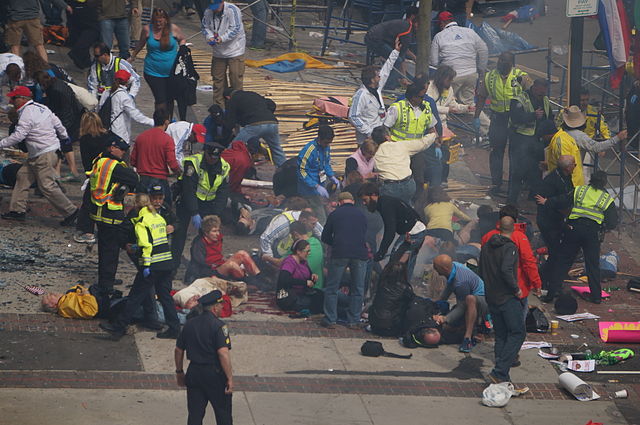
attribution cc.2.0
9-1-1 is your heroine's friend, but the truth is the nine minute time span that is about average from the time a call is placed until help arrives might just be the critical inflection point between live/won't live of your character.
Things to consider about your heroine: Is she prepared to save the day?
- Is she capable of handling stressful situations?
- Can she make good decisions in a step by step manner.
- Does she have classes in first aid? Has she kept up her credentials? Has it been awhile and she's forgotten?
- Does she have the materials available to get the job done? Can she Macgyver the situation?
- Is she physically capable to carry, lift, drag, CPR, compress or do whatever else is required of her?
- Can she delegate and lead strangers in right actions if necessary?
- Can she multitask and make sure she keeps the scene safe?
There's actually a lot that goes into a stress-scene. And all capabilities and equipment must be put into place in your plot prior to the scene.
- How does she know how to do this?
- Why is she carrying Nitrile gloves in her purse and a CPR mask in her phone case?
Readers get turned off when luck intervenes for the good guy.
If you need your heroine to save the day, make sure you've laid the groundwork.
EMS is about ten minutes away.
- People can die in ten minutes
- I know you've been trained in the ABCs (airway, breath, circulation) but military casualties have shown us that your character should stop profuse bleeding first. #1 Check for blood and stop it. A tourniquet is your character's friend don't be afraid to use it.
- If the areas is a "hot zone" the EMS will not enter. It has to be cleared by the police first.
- This is how someone gets help:
CHAIN OF SURVIVAL
- Bystanders call 9-1-1 and apply first aid.
- The police get there, they are NOT helping folks, they are securing the situation.
- EMS gets access
- transportation
- Emergency department/surgical center
Those characters who will help have these characteristics:
- experienced with how to help
- believe they can help
- recognize a threat to life that appears to be getting worse
- empathetic with the injured
Those characters who will not help:
- afraid to make things worse
- don't know what to do
- assume medical help will arrive soon
- Distortion of senses and tunnel vision. Unable to hear/discern noises
- Adrenaline - fight, flight, freeze can equate loss of function.
- Running an assessment loop
- denial
- deliberation
- action
Your character can improve her response by training her brain.
- Practice/talk through various scenarios
- Practice functioning under stress
To get to a diffusion of responsibility
- One of your characters must act first.
- One character pointing their finger and giving commands will get a response.
CAREFUL NOW - make sure your character is running on all four cylinders (or not - this would be a good way to twist your plot).
Did she interpret her surroundings before running in?
Through her adrenaline haze did she:
- See the downed power line? How about the smoke, debris, moving vehicle?
- Hear the voices, hissing, gunshot?
- Smell gasoline, smoke, chemicals?
What decisions does your character make?
First, where is she in reference to the bad stuff?
- Hot Zone - Red - active (in the room with the event)
- Might include a weather event, car crash, crime
- These are very rare
- Act quickly and move with purpose
- Yellow Zone - inactive (event nearby, potential for danger)
- Green Zone - safe space.
Does your character feel safe?
- YES - stay and provide care
- NO - can they move the injured person?
- NO - leave them, move to a safe location
- YES - get person out of harm's way
Now, it's up to you, the writer. How did you set your character up, and what will she do next? Will she succeed? Will she fail? And how does that effect her life/story?
Happy writing!
Fiona
get more information on how to save your character at the FEMA website:
www.ready.gov/until-the-help-arrives


No comments:
Post a Comment